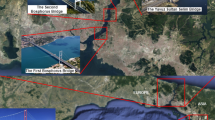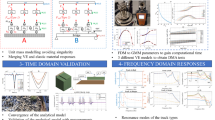Abstract
Evaluation of longitudinal force is very important for the performance evaluation of older bridges and for the design of new bridges. There is a growing demand to increase freight haulage in railway networks, in particular, on the iron ore routes of various zones of Indian railways. This proposed alteration may subject the bridges to higher tractive effort/braking forces together with higher axle loads. It is thus obvious that there is a need to check the performance of the concerned bridges under this proposed increased loading. Hence, as part of evaluating the bridges for higher axle loads, experimental investigations have been carried out on a typical steel plate girder railway bridge. This paper gives the summary of experimental investigations, test setups, and results obtained for the evaluation of longitudinal force. The longitudinal force evaluated based on the experiments for the increased axle loads is found to be within the design limits specified. The special fixtures developed for direct measurement of the longitudinal force are found to give the reliable results compared to the strain gage measurements on the girder. The results show that only part of the rail force is transmitted to the girder.
Similar content being viewed by others
References
Brownjohn, J.M.W., Moyo, P., Omenzetter, P., and Chakraborty, S., “Lessons From Monitoring the Performance of Highway Bridges,” Structural Control and Health Monitoring 12:227–244 (2005).
Otter, D.E., LoPresti, J.A., Foutch, D.A., and Tobias, D.H., “Longitudinal Forces in an Open-Deck Steel Deck Plate-Girder Bridge,” American Railway Engineering Association 98(760):101–105 (1997).
Otter, D.E., Sweeney, R.A., and Dick, S.M., “Development of Design Guidelines for Longitudinal Forces in Bridges,” Technology Digest, TTCI Pueblo, CO, 00-18 (2000).
Foutch, D.A., Kim, T.W., Otter, D.E., and Doe, B.E., “Investigation of Longitudinal Forces in a Concrete Railroad Trestle,” Journal of Bridge Engineering ASCE 11(5):618–625 (2006).
American Railway Engineering and Maintenance-of-Way Association (AREMA), Manual for Railway Engineering, Landover, MD (2004).
James, G., Analysis of traffic load effects on railway bridges, Licentiate Thesis, Royal Institute of Technology, Stockholm (2006).
Luigino, D., and Graziano, L., “Local Effects Induced by Longitudinal Forces in Composite Girders,” Journal of Bridge Engineering ASCE 8(4):245–248 (2003).
Ruge, P., and Birk, C., “Longitudinal Forces in Continuously Welded Rails on Bridge Decks due to Nonlinear Track–Bridge Interaction. Computers and Structures 85:458–475 (2007).
Indian Railway Standard, Rules Specifying the Loads for Design of Super-structure and Sub-structure of Bridges (Bridge Rules), RDSO, Lucknow, India (2005).
Author information
Authors and Affiliations
Corresponding author
Rights and permissions
About this article
Cite this article
Srinivas, V., Ramanjaneyulu, K., Kumar, K.S. et al. Evaluation of longitudinal force on a railway bridge based on strain measurements. Exp Tech 37, 55–67 (2013). https://doi.org/10.1111/j.1747-1567.2011.00747.x
Received:
Accepted:
Published:
Issue Date:
DOI: https://doi.org/10.1111/j.1747-1567.2011.00747.x




